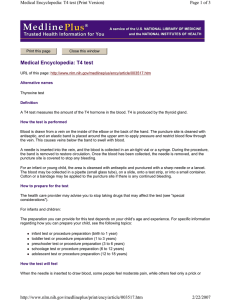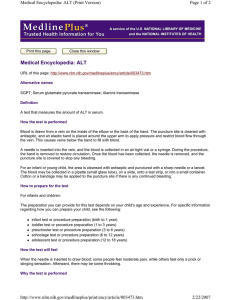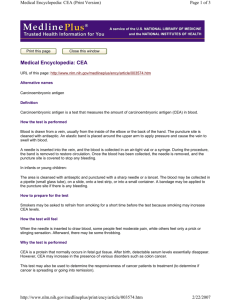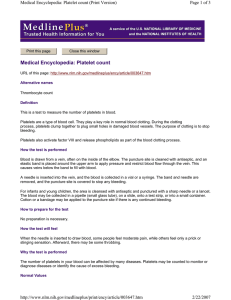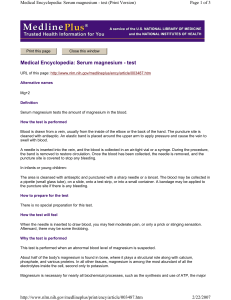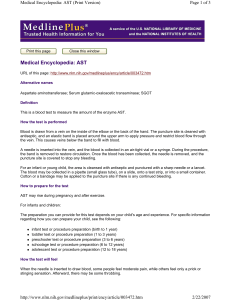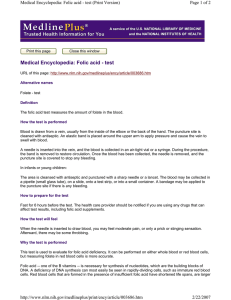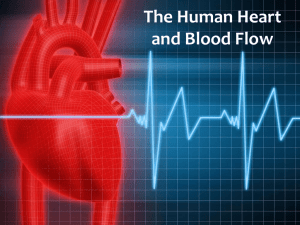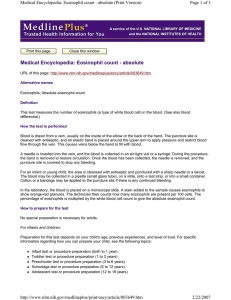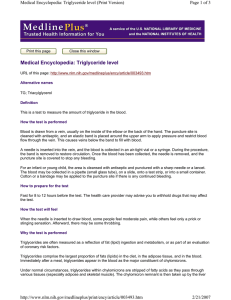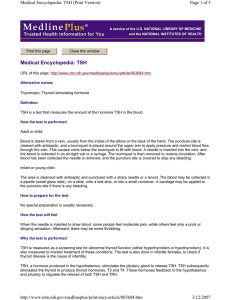Medical Encyclopedia: T3 Page 1 of 3 Medical Encyclopedia: T3 (Print Version)
advertisement
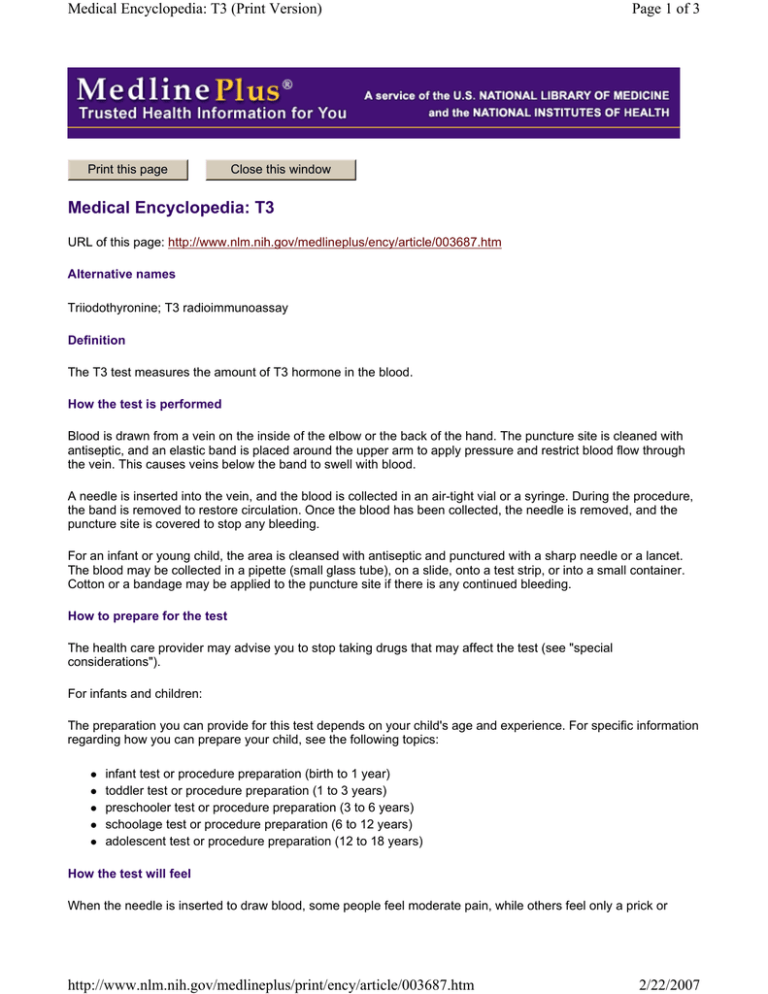
Medical Encyclopedia: T3 (Print Version) Print this page Page 1 of 3 Close this window Medical Encyclopedia: T3 URL of this page: http://www.nlm.nih.gov/medlineplus/ency/article/003687.htm Alternative names Triiodothyronine; T3 radioimmunoassay Definition The T3 test measures the amount of T3 hormone in the blood. How the test is performed Blood is drawn from a vein on the inside of the elbow or the back of the hand. The puncture site is cleaned with antiseptic, and an elastic band is placed around the upper arm to apply pressure and restrict blood flow through the vein. This causes veins below the band to swell with blood. A needle is inserted into the vein, and the blood is collected in an air-tight vial or a syringe. During the procedure, the band is removed to restore circulation. Once the blood has been collected, the needle is removed, and the puncture site is covered to stop any bleeding. For an infant or young child, the area is cleansed with antiseptic and punctured with a sharp needle or a lancet. The blood may be collected in a pipette (small glass tube), on a slide, onto a test strip, or into a small container. Cotton or a bandage may be applied to the puncture site if there is any continued bleeding. How to prepare for the test The health care provider may advise you to stop taking drugs that may affect the test (see "special considerations"). For infants and children: The preparation you can provide for this test depends on your child's age and experience. For specific information regarding how you can prepare your child, see the following topics: z z z z z infant test or procedure preparation (birth to 1 year) toddler test or procedure preparation (1 to 3 years) preschooler test or procedure preparation (3 to 6 years) schoolage test or procedure preparation (6 to 12 years) adolescent test or procedure preparation (12 to 18 years) How the test will feel When the needle is inserted to draw blood, some people feel moderate pain, while others feel only a prick or http://www.nlm.nih.gov/medlineplus/print/ency/article/003687.htm 2/22/2007 Medical Encyclopedia: T3 (Print Version) Page 2 of 3 stinging sensation. Afterward, there may be some throbbing. Why the test is performed T3 is measured as part of a thyroid function evaluation. Most of the thyroid hormone made in the thyroid is in the form of T4. The body's cells convert the T4 to T3, which is the more active hormone. Sometimes it can be useful to measure both T4 and T3 when looking at thyroid function. For example, in some cases of hyperthyroidism, T4 may be normal but T3 will be elevated. Most of the T4 and T3 in the body is attached to proteins in the blood. These proteins serve as carriers. The T3 test measures both the T3 that is bound to the proteins and the T3 that is "free" floating in the blood. The free fraction is the hormone that is active. Conditions that increase the levels of the carrier proteins -- such as pregnancy and liver disease -- will falsely raise the T3 level. In these cases, it is useful to measure either the free T3 level or to perform the RT3U test, which gives a measure of the amount of carrier protein. T4 and T3 are important hormones in the regulation of metabolism. The exact mechanisms are not understood, but it is known that T4 increases the concentrations of numerous enzymes involved in the production of energy in the body. Normal Values 100 to 200 ng/dL (nanograms per deciliter) What abnormal results mean Greater-than-normal levels may indicate: z z z hyperthyroidism (for example, Graves' disease) T3 thyrotoxicosis (rare) thyroid cancer (rare) Lower-than-normal levels may indicate: z z z chronic illness hypothyroidism (for example, Hashimoto's disease) starvation Additional conditions under which the test may be performed: z z z painless (silent) thyroiditis thyrotoxic periodic paralysis toxic nodular goiter What the risks are The only risks of the test is those minor risks associated with having blood drawn. Special considerations Drugs that can increase T3 measurements include clofibrate, estrogens, methadone, and oral contraceptives. http://www.nlm.nih.gov/medlineplus/print/ency/article/003687.htm 2/22/2007 Medical Encyclopedia: T3 (Print Version) Page 3 of 3 Drugs that can decrease T3 measurements include anabolic steroids, androgens, antithyroid drugs (for example, propylthiouracil), lithium, phenytoin, and propranolol. Update Date: 1/18/2006 Updated by: Nikheel S. Kolatkar, MD, Clinical and Research Fellow, Division of Endocrinology, Diabetes, and Hypertension, Brigham and Women's Hospital, Harvard Medical School, Boston, MA. Review provided by VeriMed Healthcare Network. A.D.A.M., Inc. is accredited by URAC, also known as the American Accreditation HealthCare Commission (www.urac.org). URAC's accreditation program is the first of its kind, requiring compliance with 53 standards of quality and accountability, verified by independent audit. A.D.A.M. is among the first to achieve this important distinction for online health information and services. Learn more about A.D.A.M.'s editorial process. A.D.A.M. is also a founding member of Hi-Ethics (www.hiethics.com) and subscribes to the principles of the Health on the Net Foundation (www.hon.ch). The information provided should not be used during any medical emergency or for the diagnosis or treatment of any medical condition. A licensed physician should be consulted for diagnosis and treatment of any and all medical conditions. Call 911 for all medical emergencies. Adam makes no representation or warranty regarding the accuracy, reliability, completeness, currentness, or timeliness of the content, text or graphics. Links to other sites are provided for information only -- they do not constitute endorsements of those other sites. Copyright 2005, A.D.A.M., Inc. Any duplication or distribution of the information contained herein is strictly prohibited. http://www.nlm.nih.gov/medlineplus/print/ency/article/003687.htm 2/22/2007
